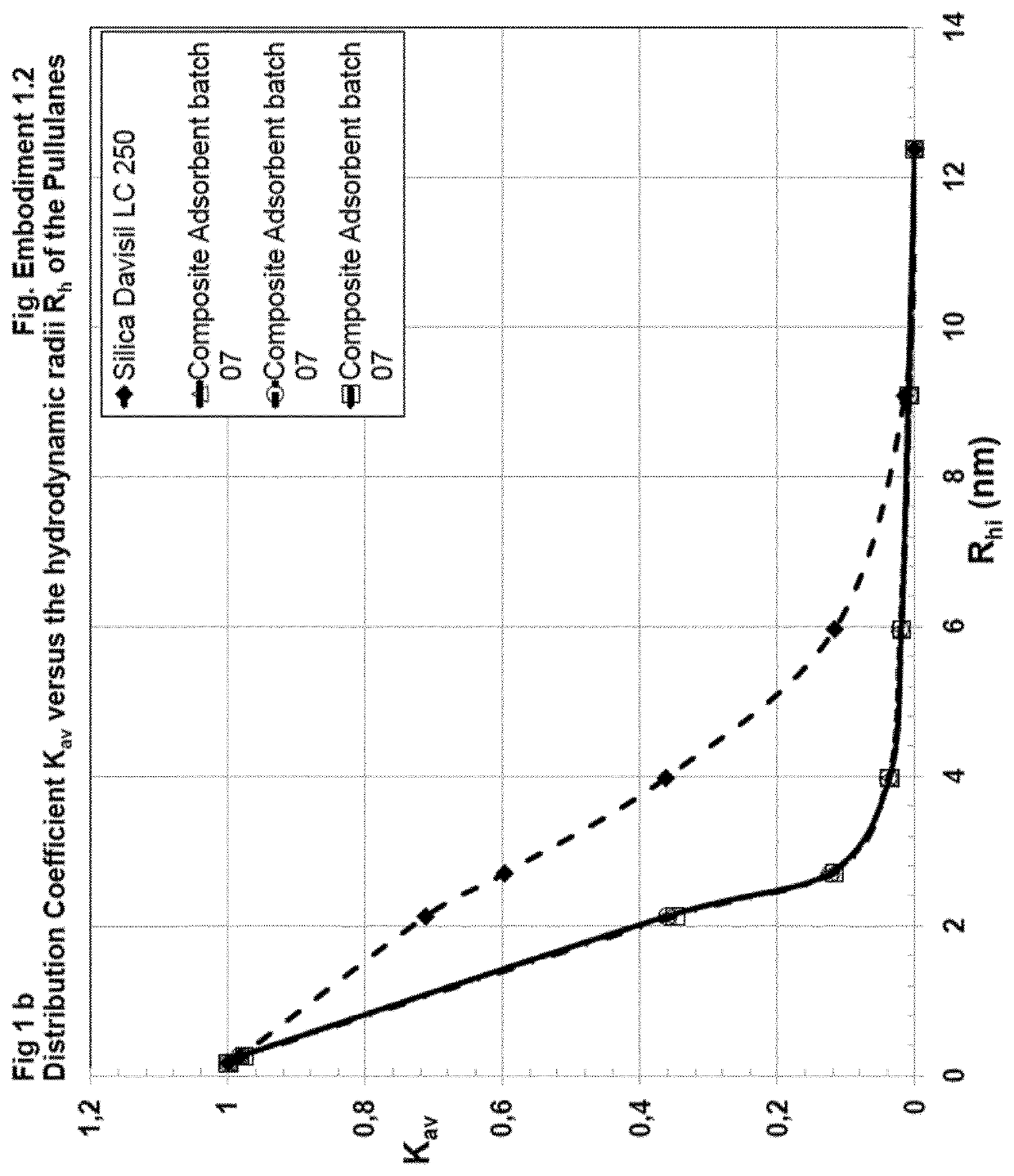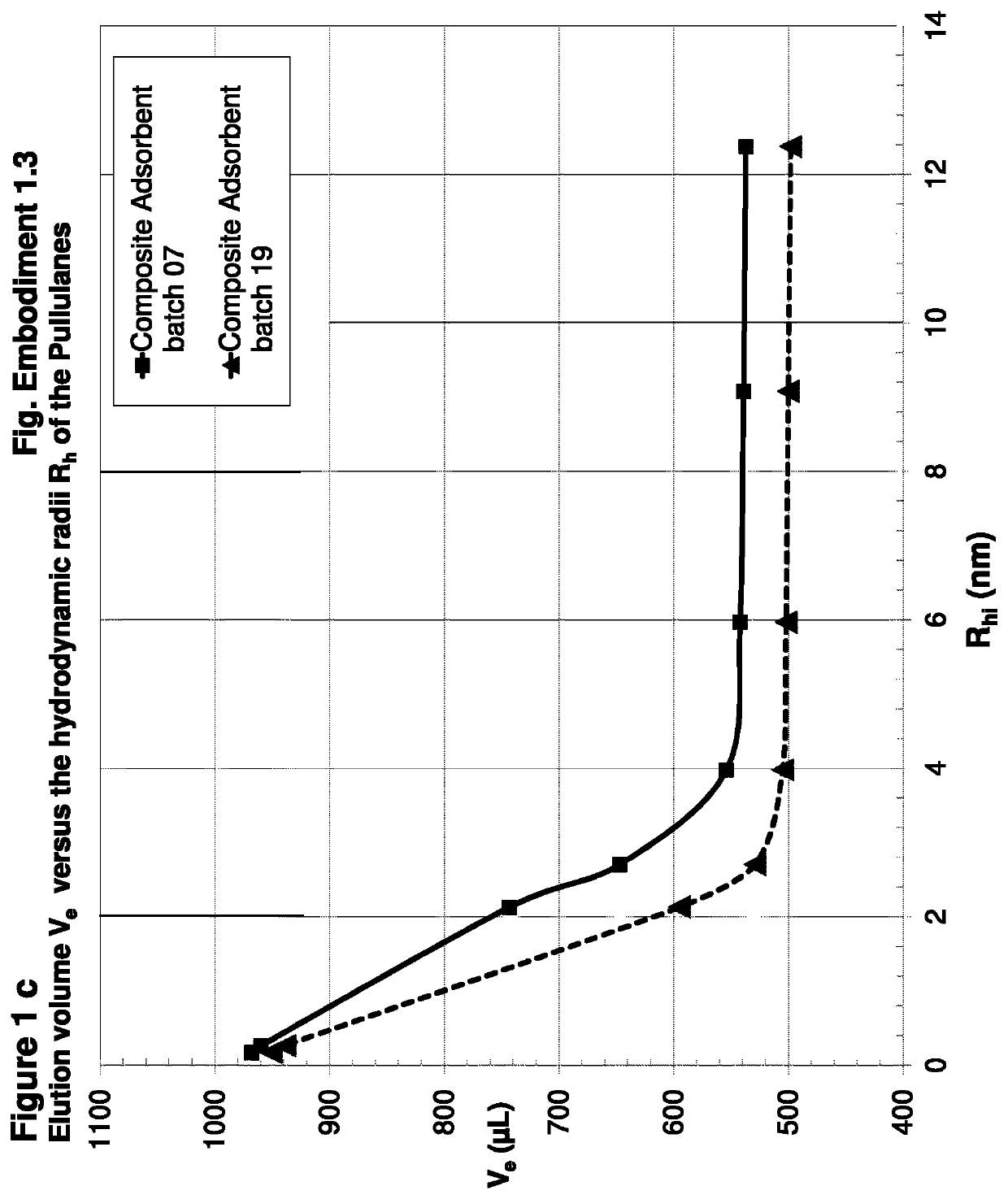Use of a polymeric mesh for the purification of macromolecules
a polymer mesh and macromolecule technology, applied in the field of polymer mesh, can solve the problems of poor mass transfer of modified products, general recommendation not to mix functional polymers, etc., and achieve the effect of high yield and high yield
- Summary
- Abstract
- Description
- Claims
- Application Information
AI Technical Summary
Benefits of technology
Problems solved by technology
Method used
Image
Examples
example 1
[0324]Preparation of Composite Adsorbent Batch 07 (Table 1)
[0325]704 μl (658 mg) of hexane diol diclycidylether (Mw 230.2, d=1.07 g / ml) cross-linker were dissolved in 42 ml water. This cross-linker solution was added to 15 ml of an aqueous solution of poly(vinylformamid-co-polyvinylamin) (Lupamin 45-70, partially hydrolysed, see materials). After mixing, the pH of 11 was adjusted with 3 ml of 0.5 M NaOH.
[0326]10 g of Silica Gel Davisil LC 250, 40-63 μm (W. R. Grace), dry powder, were sedimented into a flat bottom stainless steel dish with 8 cm diameter. The bed height was 8 mm. 39.5 g of the polymer-cross-linker solution were added and equally distributed over the silica, whereas the solution was rapidly soaked in the pores. The resultant paste was shaken for 1 min. on a gyratory shaker at 600 rpm, in order to obtain a homogeneous mass with smooth surface, covered by a liquid film of 1-3 mm. After closing the dish with a stainless steel lid, the paste was heated without further mixi...
reference example 1
[0329](Preparation of a Cross-Linked Polyvinylamine Gel)
[0330]In order to check the reaction without support material, 3 ml of the polymer-cross-linking agent solution of Example 1 was heated for 24 hours at 50° C. After six hours the gelation was visible. After 24 hours one piece of a transparent solid elastic gel was obtained.
example 1a
[0331]Preparation of a Composite Adsorbent Using a Small Particle Support Material.
[0332]1 ml (935 mg) of hexane diol diclycidylether (Mw 230.2, d=1.07 g / ml) cross-linker were shaken with 59 ml water, forming a homogeneous emulsion. This cross-linker solution was added to 21 ml of an aqueous solution of poly(vinylformamid-co-polyvinylamin) (Lupamin 45-70, raw and untreated).
[0333]After mixing, a pH of 10 was adjusted with 0.5 M NaOH.
[0334]25 g of Silica Eurosil Bioselect 300-5, 5 μm, dry powder, were sedimented into a flat bottom stainless steel dish with 12 cm diameter. The bed height was about 15 mm. 46 g of the polymer-cross-linker solution were added and equally distributed over the silica, whereas the solution was soaked in the pores, forming a viscous, mucous mass. After adding of a 1.5 ml portion of the polymer-cross-linker solution and finally of 4 ml diluted polymer (1 ml of poly(vinylformamide-co-polyvinylamine) diluted with 3 ml of water) the suspension became smooth and ...
PUM
| Property | Measurement | Unit |
|---|---|---|
| pore size | aaaaa | aaaaa |
| pore size | aaaaa | aaaaa |
| hydrodynamic radius Rh2 | aaaaa | aaaaa |
Abstract
Description
Claims
Application Information
 Login to view more
Login to view more - R&D Engineer
- R&D Manager
- IP Professional
- Industry Leading Data Capabilities
- Powerful AI technology
- Patent DNA Extraction
Browse by: Latest US Patents, China's latest patents, Technical Efficacy Thesaurus, Application Domain, Technology Topic.
© 2024 PatSnap. All rights reserved.Legal|Privacy policy|Modern Slavery Act Transparency Statement|Sitemap



